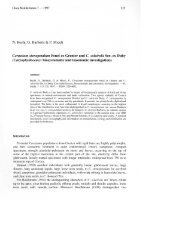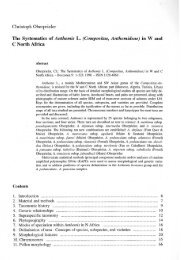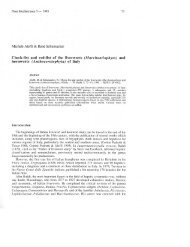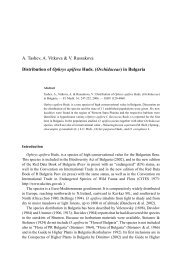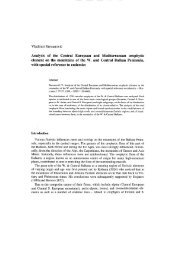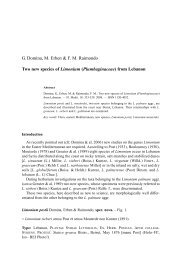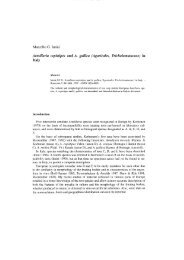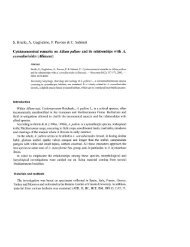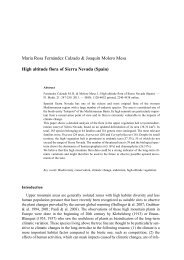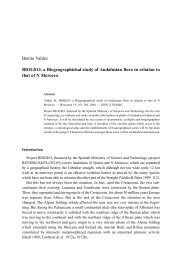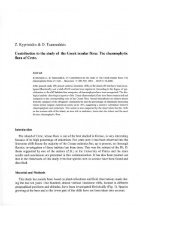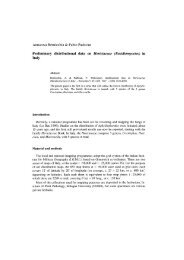You also want an ePaper? Increase the reach of your titles
YUMPU automatically turns print PDFs into web optimized ePapers that Google loves.
44 Peruzzi & al.: Distribution of the genus Gagea (<strong>Liliaceae</strong>) <strong>in</strong> <strong>Sicily</strong><br />
Analitical key for the identification of the studied species (for further <strong>in</strong>formation about<br />
the sectional sett<strong>in</strong>g of the genus Gagea, cfr. Peruzzi & Tison 2004)<br />
(identification on complete and preferably fresh samples is recommended)<br />
1. Flowers white ...............................................................................................G. tr<strong>in</strong>ervia<br />
1. Flowers yellow ...............................................................................................................2<br />
2. Basal leaves one .............................................................................................................3<br />
2. Basal leaves two .............................................................................................................5<br />
3. Bulb scale <strong>in</strong>serted with<strong>in</strong> tunics ....................................................................................4<br />
3. Bulb scale (and basal bulbil) exserted from the tunics ................................G. pratensis<br />
4. Basal leaf fistular, semicyl<strong>in</strong>dric, with vascular bundles r<strong>in</strong>g-arranged, stem cyl<strong>in</strong>dric .<br />
.......................................................................................................................G. fragifera<br />
4. Basal leaf not fistular, bifacial, stem angular.......................................................G. lutea<br />
5. Basal leaves fistular (section!), semicyl<strong>in</strong>dric ................................................................6<br />
5. Basal leaves not as above ...............................................................................................7<br />
6. Basal leaves less than 1.5 mm wide, slightly fistular ..................................G. lojaconoi<br />
6. Basal leaves more than 1.5 mm wide, strongly fistular .....(immature plants of) G. fragifera<br />
7. Massive presence of thickened (up to 1 mm) ageotropic roots surround<strong>in</strong>g the bulb .........8<br />
7. Thickened ageotropic roots absent ...............................................................................11<br />
8. Basal leaves 1-1.5(2) mm wide, with 3-5(7) vascular bundles; pedicels (15)20-30(35)<br />
mm long ..................................................................................................G. mauritanica<br />
8. Basal leaves 2-7 mm wide, with 5-9(11) vascular bundles; pedicels (10)20-60 mm long ...<br />
.........................................................................................................................................9<br />
9. Basal leaves flat, (2)3-4(7) mm wide; mature plants (3.5)4.5-8.5(12) cm tall ............10<br />
9. Basal leaves “v” shaped, 2-3 mm wide; mature plants 11-17 cm tall ...............G. dubia<br />
10. Basal leaves 2(3) mm wide, light green; <strong>in</strong>florescence above the ground ......... G. lacaitae<br />
10. Basal leaves 3-4(7) mm wide, green; <strong>in</strong>florescence at the ground level .........G. granatellii<br />
11. Basal leaves filiform-cyl<strong>in</strong>dric, with 3 vascular bundles “v” arranged, at most 1 mm<br />
wide ..............................................................................................................................12<br />
11. Basal leaves l<strong>in</strong>ear, with 3-9 vascular bundles, 1-3(4) mm wide ...............................14<br />
12. Basal leaves not fistular ..............................................................................................13<br />
12. Basal leaves slightly fistular .......................................................................G. lojaconoi<br />
13. Pedicels (4)6-10(15) mm long, tepals (9)11-14(16) mm long ..................G. bohemica<br />
13. Pedicels (24)35-45(50) mm long, tepals (15)16-18(20) mm long ......G. peduncularis<br />
14. Tepals (6)7.5-9(11) mm long, with obtuse apex; buds usually nodd<strong>in</strong>g ....................15<br />
14. Tepals larger, with acute or sub-acute apex; buds erect .............................................16<br />
15. Pedicels (5)6-16(20) mm long; buds nodd<strong>in</strong>g or erect ....................................G. sicula<br />
15. Pedicels 40 mm long; buds nodd<strong>in</strong>g .......................................................G. chrysantha<br />
16. Basal leaves with 7-9 vascular bundles; plants hairy .....................................G. villosa<br />
16. Basal leaves with 5 vascular bundles; plants glabrous or glabrescent ...........G. foliosa<br />
Acknowledgements<br />
This work was carried out thanks to Fondi di Ateneo (EX60%) of the University of Pisa. The authors<br />
wish to thank the Curators of Herbaria of Catania (CAT), University of Calabria (CLU), Firenze (FI),



